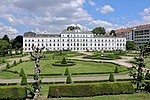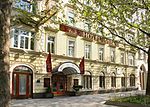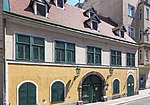Pazmanitentempel

The Pazmanitentempel, also known as the Synagoge in der Leopoldstadt, Pazmanitengasse 6, was a large synagogue in Vienna's second district Leopoldstadt. It was designed and constructed by the architect Ignaz Reiser and dedicated on 28 September 1913. The building was financed by Adolf Schramek (1845–1915) who signed the contract with the builder in 1910. Originally from Leipnik, Moravia, Schramek became one of Vienna's most successful coal merchants. The Pazmaniten synagogue was, therefore, not built by the Kultusgemeinde but by a temple club (Verein) Am Volkert, or Aeschel Awrachom (Tent of Abraham) of which Schramek was the president. Plans and photographs of the virtual reconstruction of the synagogue are illustrated in the book "The Destroyed Synagogues of Vienna" (2009) by Martens and Peter. The synagogue, once described as the most beautiful in Vienna, was destroyed during the Nazi pogroms of the Reichskristallnacht after the Anschluss of Austria to Nazi Germany in 1938.
Excerpt from the Wikipedia article Pazmanitentempel (License: CC BY-SA 3.0, Authors, Images).Pazmanitentempel
Pazmanitengasse, Vienna KG Leopoldstadt (Leopoldstadt)
Geographical coordinates (GPS) Address Nearby Places Show on map
Geographical coordinates (GPS)
| Latitude | Longitude |
|---|---|
| N 48.2204444444 ° | E 16.3846388889 ° |
Address
Pazmanitengasse 6
1020 Vienna, KG Leopoldstadt (Leopoldstadt)
Austria
Open on Google Maps











